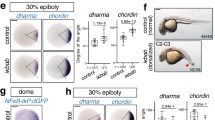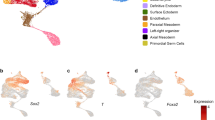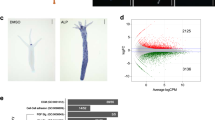Abstract
Local expression of FGF8 at the mid/hindbrain boundary (MHB) governs the development of multiple neurons and support cells. Here we show that the paired-domain protein Pax2 is necessary and sufficient for the induction of FGF8 in part by regulating the expression of Pax5&8. A network of transcription and secreted factors, including En1, Otx2, Gbx2, Grg4 and Wnt1&4, that is established independently of Pax2, further refines the expression domain and level of FGF8 at the MHB through opposing effects on Pax2 activity. Our results indicate that the expression of local organizing factors is controlled by combinatorial interaction between inductive and modulatory factors.
This is a preview of subscription content, access via your institution
Access options
Subscribe to this journal
Receive 12 print issues and online access
$209.00 per year
only $17.42 per issue
Buy this article
- Purchase on Springer Link
- Instant access to full article PDF
Prices may be subject to local taxes which are calculated during checkout






Similar content being viewed by others
References
Martinez, S., Wassef, M. & Alvarado-Mallart, R. M. Induction of a mesencephalic phenotype in the 2-day-old chick prosencephalon is preceded by the early expression of the homeobox gene en. Neuron 6, 971–981 (1991).
Marin, F. & Puelles, L. Patterning of the embryonic avian midbrain after experimental inversions: a polarizing activity from the isthmus. Dev. Biol. (Orlando) 163, 19–37 (1994).
Crossley, P. H., Martinez, S. & Martin, G. R. Midbrain development induced by FGF8 in the chick embryo. Nature 380, 66–68 (1996).
Hidalgo-Sanchez, M., Millet, S., Simeone, A. & Alvarado-Mallart, R. M. Comparative analysis of Otx2, Gbx2, Pax2, Fgf8 and Wnt1 gene expressions during the formation of the chick midbrain/hindbrain domain. Mech. Dev. 81, 175–178 (1999).
Liu, A. & Joyner, A. L. EN and GBX2 play essential roles downstream of FGF8 in patterning the mouse mid/hindbrain region. Development 128, 181–191 (2001).
Boncinelli, E., Gulisano, M. & Broccoli, V. Emx and Otx homeobox genes in the developing mouse brain. J. Neurobiol. 24, 1356–1366 (1993).
Bouillet, P., Chazaud, C., Oulad-Abdelghani, M., Dollé, P. & Chambon, P. Sequence and expression pattern of the Stra7 (Gbx-2) homeobox-containing gene induced by retinoic acid in P19 embryonal carcinoma cells. Dev. Dyn. 204, 372–382 (1995).
Hollyday, M., McMahon, J. A. & McMahon, A. P. Wnt expression patterns in chick embryo nervous system. Mech. Dev. 52, 9–25 (1995).
Millet, S. et al. A role for Gbx2 in repression of Otx2 and positioning the mid/hindbrain organizer. Nature 401, 161–164 (1999).
Broccoli, V., Boncinelli, E. & Wurst, W. The caudal limit of Otx2 expression positions the isthmic organizer. Nature 401, 164–168 (1999).
Katahira, T. et al. Interaction between Otx2 and Gbx2 defines the organizing center for the optic tectum. Mech. Dev. 91, 43–52 (2000).
Wassarman, K. M. et al. Specification of the anterior hindbrain and establishment of a normal mid/hindbrain organizer is dependent on Gbx2 gene function. Development 124, 2923–2934 (1997).
Rhinn, M. et al. Sequential roles for Otx2 in visceral endoderm and neuroectoderm for forebrain and midbrain induction and specification. Development 125, 845–856 (1998).
Rhinn, M., Dierich, A., Le Meur, M. & Ang, S. Cell autonomous and non-cell autonomous functions of Otx2 in patterning the rostral brain. Development 126, 4295–4304 (1999).
Koop, K. E., MacDonald, L. M. & Lobe, C. G. Transcripts of Grg4, a murine groucho-related gene, are detected in adjacent tissues to other murine neurogenic gene homologues during embryonic development. Mech. Dev. 59, 73–87 (1996).
Eberhard, D., Jimenez, G., Heavey, B. & Busslinger, M. Transcriptional repression by Pax5 (BSAP) through interaction with corepressors of the Groucho family. EMBO J. 19, 2292–2303 (2000).
Sugiyama, S., Funahashi, J. & Nakamura, H. Antagonizing activity of chick Grg4 against tectum-organizing activity. Dev. Biol. 221, 168–180 (2000).
Danielian, P. S. & McMahon, A. P. Engrailed-1 as a target of the Wnt-1 signalling pathway in vertebrate midbrain development. Nature 383, 332–334 (1996).
Simeone, A. Positioning the isthmic organizer where Otx2 and Gbx2 meet. Trends Genet. 16, 237–240 (2000).
Dressler, G. R., Deutsch, U., Chowdhury, K., Nornes, H. O. & Gruss, P. Pax2, a new murine paired-box-containing gene and its expression in the developing excretory system. Development 109, 787–795 (1990).
Pfeffer, P. L., Bouchard, M. & Busslinger, M. Pax2 and homeodomain proteins cooperatively regulate a 435 bp enhancer of the mouse Pax5 gene at the midbrain–hindbrain boundary. Development 127, 1017–1028 (2000).
Okafuji, T., Funahashi, J. & Nakamura, H. Roles of Pax-2 in initiation of the chick tectal development. Brain Res. Dev. Brain Res. 116, 41–49 (1999).
Acampora, D. et al. Visceral endoderm-restricted translation of Otx1 mediates recovery of Otx2 requirements for specification of anterior neural plate and normal gastrulation. Development 125, 5091–5104 (1998).
Bouchard, M., Pfeffer, P. & Busslinger, M. Functional equivalence of the transcription factors Pax2 and Pax5 in mouse development. Development 127, 3703–3713 (2000).
Urbanek, P., Fetka, I., Meisler, M. H. & Busslinger, M. Cooperation of Pax2 and Pax5 in midbrain and cerebellum development. Proc. Natl. Acad. Sci. USA 94, 5703–5708 (1997).
Mallo, M., Franco del Amo, F. & Gridley, T. Cloning and developmental expression of Grg, a mouse gene related to the groucho transcript of the Drosophila Enhancer of split complex. Mech. Dev. 42, 67–76 (1993).
McMahon, A. P., Joyner, A. L., Bradley, A. & McMahon, J. A. The midbrain–hindbrain phenotype of Wnt-1-/Wnt-1- mice results from stepwise deletion of engrailed-expressing cells by 9.5 days postcoitum. Cell 69, 581–595 (1992).
Araki, I. & Nakamura, H. Engrailed defines the position of dorsal di-mesencephalic boundary by repressing diencephalic fate. Development 126, 5127–5135 (1999).
Shamim, H. et al. Sequential roles for Fgf4, En1 and Fgf8 in specification and regionalisation of the midbrain. Development 126, 945–959 (1999).
Nakamura, H., Nakano, K. E., Igawa, H. H., Takagi, S. & Fujisawa, H. Plasticity and rigidity of differentiation of brain vesicles studied in quail-chick chimeras. Cell Differ. 19, 187–193 (1986).
Ye, W., Shimamura, K., Rubenstein, J. L., Hynes, M. A. & Rosenthal, A. FGF and Shh signals control dopaminergic and serotonergic cell fate in the anterior neural plate. Cell 93, 755–766 (1998).
Meyers, E. N., Lewandoski, M. & Martin, G. R. An Fgf8 mutant allelic series generated by Cre- and Flp-mediated recombination. Nat. Genet. 18, 136–141 (1998).
Nieuwkoop, P. D. The successive steps in the pattern formation of the amphibian central nervous system. Dev. Growth Differ. 32, 149–154 (1989).
Irving, C. & Mason, I. Regeneration of isthmic tissue is the result of a specific and direct interaction between rhombomere 1 and midbrain. Development 126, 3981–3989 (1999).
Ang, S.-L. & Rossant, J. Anterior mesendoderm induces mouse Engrailed genes in explant cultures. Development 118, 139–149 (1993).
Wurst, W. & Bally-Cuif, L. Neural plate patterning: upstream and downstream of the isthmic organizer. Nat. Rev. Neurosci. 2, 99–108 (2001).
Funahashi, J. et al. Role of Pax-5 in the regulation of a mid-hindbrain organizer's activity. Dev. Growth Differ. 41, 59–72 (1999).
Liu, A., Losos, K. & Joyner, A. L. FGF8 can activate Gbx2 and transform regions of the rostral mouse brain into a hindbrain fate. Development 126, 4827–4838 (1999).
Gemel, J., Jacobsen, C. & MacArthur, C. A. Fibroblast growth factor-8 expression is regulated by intronic engrailed and Pbx1-binding sites. J. Biol. Chem. 274, 6020–6026 (1999).
Li Song, D. & Joyner, A. L. Two Pax2/5/8-binding sites in Engrailed2 are required for proper initiation of endogenous mid-hindbrain expression. Mech. Dev. 90, 155–165 (2000).
Lee, S. M., Danielian, P. S., Fritzsch, B. & McMahon, A. P. Evidence that FGF8 signalling from the midbrain–hindbrain junction regulates growth and polarity in the developing midbrain. Development 124, 959–969 (1997).
Martinez, S., Crossley, P. H., Cobos, I., Rubenstein, J. L. & Martin, G. R. FGF8 induces formation of an ectopic isthmic organizer and isthmocerebellar development via a repressive effect on Otx2 expression. Development 126, 1189–1200 (1999).
McMahon, A. P. & Bradley, A. The Wnt-1 (int-1) proto-oncogene is required for development of a large region of the mouse brain. Cell 62, 1073–1085 (1990).
Thomas, K. R. & Capecchi, M. R. Targeted disruption of the murine int-1 proto-oncogene resulting in severe abnormalities in midbrain and cerebellar development. Nature 346, 847–850 (1990).
Wurst, W., Auerbach, A. B. & Joyner, A. L. Multiple developmental defects in Engrailed-1 mutant mice: an early mid-hindbrain deletion and patterning defects in forelimbs and sternum. Development 120, 2065–2075 (1994).
Hynes, M. et al. The seven-transmembrane receptor smoothened cell-autonomously induces multiple ventral cell types. Nat. Neurosci. 3, 41–46 (2000).
Ang, S.-L., Conlon, R. A., Jin, O. & Rossant, J. Positive and negative signals from mesoderm regulate the expression of mouse Otx2 in ectoderm explants. Development 120, 2979–2989 (1994).
Acknowledgements
We thank A. Joyner for sharing unpublished results and for the chick En1 and En2 cDNAs, G. Martin, J. Rubenstein and E. Miyashita for Gbx2 mutant mice, A. Simeone for the full-length mouse and partial chick Otx2 cDNAs, A. Leutz for the full-length chick Gbx2 cDNA, G. Martin for the chick FGF8 cDNA, A. Lumsden for the chick Hoxa2 cDNA, A. McMahon for the chick Wnt1 and Wnt4 cDNAs and S. Greenwood for reading the manuscript. This research was supported in part by Boehringer Ingelheim.
Author information
Authors and Affiliations
Corresponding author
Rights and permissions
About this article
Cite this article
Ye, W., Bouchard, M., Stone, D. et al. Distinct regulators control the expression of the mid-hindbrain organizer signal FGF8. Nat Neurosci 4, 1175–1181 (2001). https://doi.org/10.1038/nn761
Received:
Accepted:
Published:
Issue Date:
DOI: https://doi.org/10.1038/nn761
This article is cited by
-
Dissection of the Fgf8 regulatory landscape by in vivo CRISPR-editing reveals extensive intra- and inter-enhancer redundancy
Nature Communications (2021)
-
Genetic studies of myelomeningocele
Child's Nervous System (2013)
-
Evolution of developmental roles of Pax2/5/8paralogs after independent duplication in urochordate and vertebrate lineages
BMC Biology (2008)



